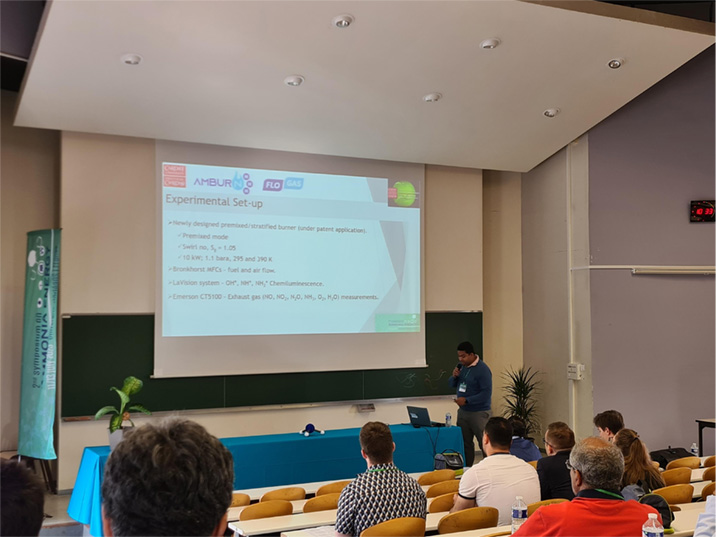Amburn participates to world leading Ammonia Symposium

The symposium took place following the success of the first issue, the year prior, and aimed to develop conversations and knowledge sharing on the state of the art of ammonia technology. The 137 presentations that were given at the three-day event were split into 11 different key topics across the ammonia value chain:
- Reaction kinetics
- Laminar flames
- Internal combustion engines
- Cracking systems
- Production
- Economic and environmental aspects 7. Gas turbines
- Sprays
- Emissions
- Innovative systems
- Turbulent combustion
The broad range of topics allowed the discussions and presentations held to span all areas of ammonia use, both discussing its use as a direct fuel in various applications as well as its role in the broader decarbonisation as a hydrogen vector.
Green ammonia’s key role in pushing for a net zero future is in fact two-fold, with both of these roles playing major parts in all pathways to net zero around the world. Ammonia as a direct fuel is mainly being considered for applications such as gas turbines, heating systems and internal combustion engines. Here its use to replace the combustion of fossil fuels has the evident advantage of not emitting any carbon dioxide emissions. There are however some key complications with combusting ammonia, notably the emission of NOx molecules which have very high global warming potential and thus need to be omitted.

The other role of ammonia is to use it as a hydrogen carrier. Again, this provides clear advantages when the ammonia is produced in a renewable manner as it will have no net carbon footprint. However, the cracking process where hydrogen is extracted out of the ammonia is one that is technologically limiting the value chain development and commercial readiness. The temperatures and energy requirements for the cracking process are very high, and although they have been decreasing in the past years thanks to research activity in the field, there is still work to be done. The ammonia symposium thus was the perfect place to discuss all these topics, with over 100 academic papers being presented, all of which aimed to solve some of these issues or pose innovative solutions.
The conference was an ideal place for interaction between industry members and researchers, to better portray and collectively start to decide which directions the ammonia sector should take, and which technologies will be most important in supporting the energy transition. The Amburn project was pleased to attend the Ammonia Symposium. It had the chance to display its Phase 1 poster for the duration of the whole event, being the only project to have done so. Key members involved in the project also delivered presentations related to Amburn:
Effects of temperature and humidification in 20% (vol.) cracked ammonia swirling flames, by Dr. Syed Mashruk
The presentation looked to at the effects of different configurations in the combustion of ammonia as a direct fuel. The ammonia combustion process has a percentage of the ammonia that is first cracked to extract the hydrogen, and then combusted simultaneously. The experimental set up that was used to run this experiment is the burner that has been developed for the Amburn project. This is a 10 kW premixed/stratified burner, currently under patent application, which operates in a premixed mode at 1.1 bar, 295-390 K and has a swirl number of 1.05. The percentage of cracked ammonia in the mixture explored here is of 20%, as this has been shown to give the best combustion results.
The quality of combustion is typically measured through observing or modelling of the flame behaviour, with key parameters to look out for being laminar flame speed, ignition delay time and NOx emissions. The presentation covered a range of different temperature and humidification ranges in the combustion reaction, to try and determine the optimal conditions for combustion for high energy applications.
Use of ammonia blends in gas turbines for NOx abatement, by Prof. Augustin Valera Medina
This presentation was focused on examining the ideal ammonia blend to use in the combustion process to minimise NOx emissions at the tailpipe. The presentation covered a more general description of why ammonia is a key fuel as part of the energy transition, and some of the main issues faced for ammonia to become a viable, large scale fuel replacement to fossil fuels in large energy demanding applications such as gas turbines. The specifics of the experiment being presented looked at varying blends of ammonia to hydrogen ratios in the combustion chamber, and how they affect the combustion performance. It was found that a ratio of 0.3H2 to 0.7NH3 is what provides the most optimal combustion characteristics. There was high interest from industrial gas turbines manufacturers and operators who attended the session and all engaged in conversations after the talk to see how these solutions could be implemented to convert their systems to burning ammonia.

The Amburn project continues to have a key role at the forefront of ammonia technology and innovation as it progresses with testing and demonstration of its first-of-a-kind ammonia burner design. The project will attend the third iteration of the Ammonia Symposium in Shanghai, China in September 2024.
Other news



